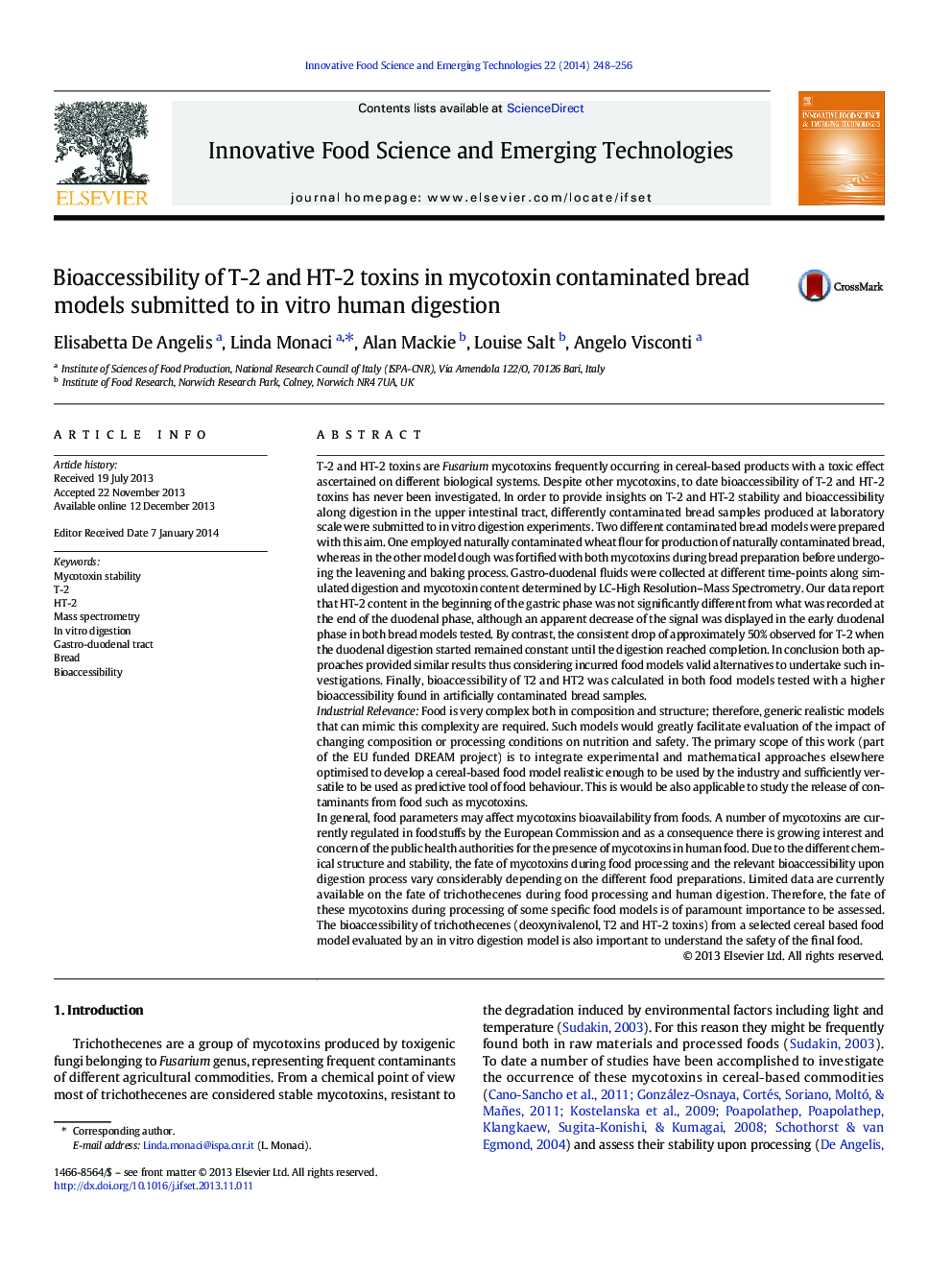| کد مقاله | کد نشریه | سال انتشار | مقاله انگلیسی | نسخه تمام متن |
|---|---|---|---|---|
| 2086643 | 1545544 | 2014 | 9 صفحه PDF | دانلود رایگان |

• Bread naturally and artificially contaminated with T-2 and HT-2 underwent in vitro digestion.
• A similar behavior was displayed for T-2 and HT-2 in both contaminated models investigated.
• HT-2 content at end of duodenal phase was not different from that at the beginning of gastric phase.
• T-2 showed to half its content during simulated gastro-duodenal digestion.
• Bioaccessibility was higher for HT2 (from 87 to 110%) compared to what was found for T2 (from 25 to 52%).
T-2 and HT-2 toxins are Fusarium mycotoxins frequently occurring in cereal-based products with a toxic effect ascertained on different biological systems. Despite other mycotoxins, to date bioaccessibility of T-2 and HT-2 toxins has never been investigated. In order to provide insights on T-2 and HT-2 stability and bioaccessibility along digestion in the upper intestinal tract, differently contaminated bread samples produced at laboratory scale were submitted to in vitro digestion experiments. Two different contaminated bread models were prepared with this aim. One employed naturally contaminated wheat flour for production of naturally contaminated bread, whereas in the other model dough was fortified with both mycotoxins during bread preparation before undergoing the leavening and baking process. Gastro-duodenal fluids were collected at different time-points along simulated digestion and mycotoxin content determined by LC-High Resolution–Mass Spectrometry. Our data report that HT-2 content in the beginning of the gastric phase was not significantly different from what was recorded at the end of the duodenal phase, although an apparent decrease of the signal was displayed in the early duodenal phase in both bread models tested. By contrast, the consistent drop of approximately 50% observed for T-2 when the duodenal digestion started remained constant until the digestion reached completion. In conclusion both approaches provided similar results thus considering incurred food models valid alternatives to undertake such investigations. Finally, bioaccessibility of T2 and HT2 was calculated in both food models tested with a higher bioaccessibility found in artificially contaminated bread samples.Industrial Relevance: Food is very complex both in composition and structure; therefore, generic realistic models that can mimic this complexity are required. Such models would greatly facilitate evaluation of the impact of changing composition or processing conditions on nutrition and safety. The primary scope of this work (part of the EU funded DREAM project) is to integrate experimental and mathematical approaches elsewhere optimised to develop a cereal-based food model realistic enough to be used by the industry and sufficiently versatile to be used as predictive tool of food behaviour. This is would be also applicable to study the release of contaminants from food such as mycotoxins.In general, food parameters may affect mycotoxins bioavailability from foods. A number of mycotoxins are currently regulated in foodstuffs by the European Commission and as a consequence there is growing interest and concern of the public health authorities for the presence of mycotoxins in human food. Due to the different chemical structure and stability, the fate of mycotoxins during food processing and the relevant bioaccessibility upon digestion process vary considerably depending on the different food preparations. Limited data are currently available on the fate of trichothecenes during food processing and human digestion. Therefore, the fate of these mycotoxins during processing of some specific food models is of paramount importance to be assessed. The bioaccessibility of trichothecenes (deoxynivalenol, T2 and HT-2 toxins) from a selected cereal based food model evaluated by an in vitro digestion model is also important to understand the safety of the final food.
Journal: Innovative Food Science & Emerging Technologies - Volume 22, April 2014, Pages 248–256